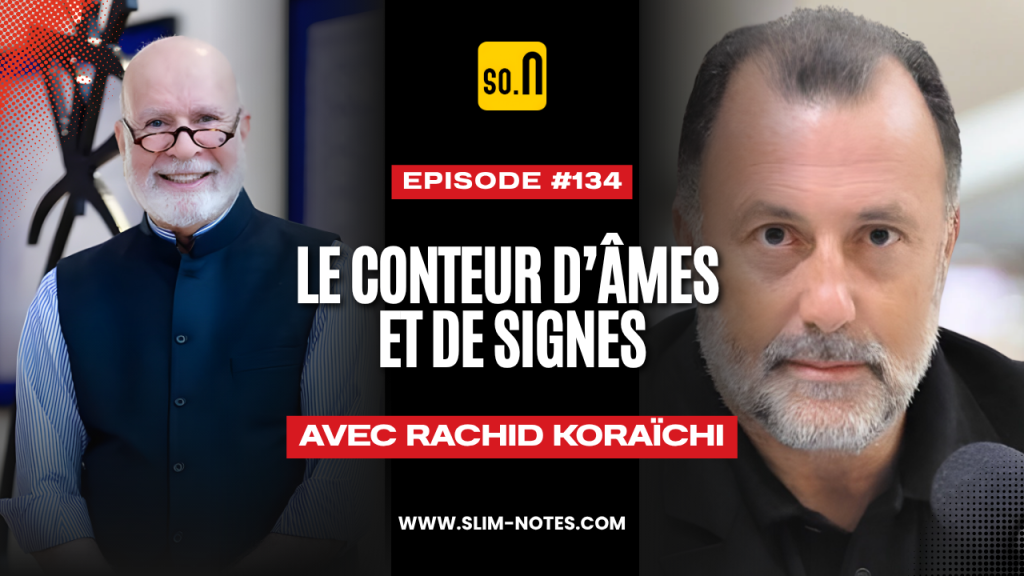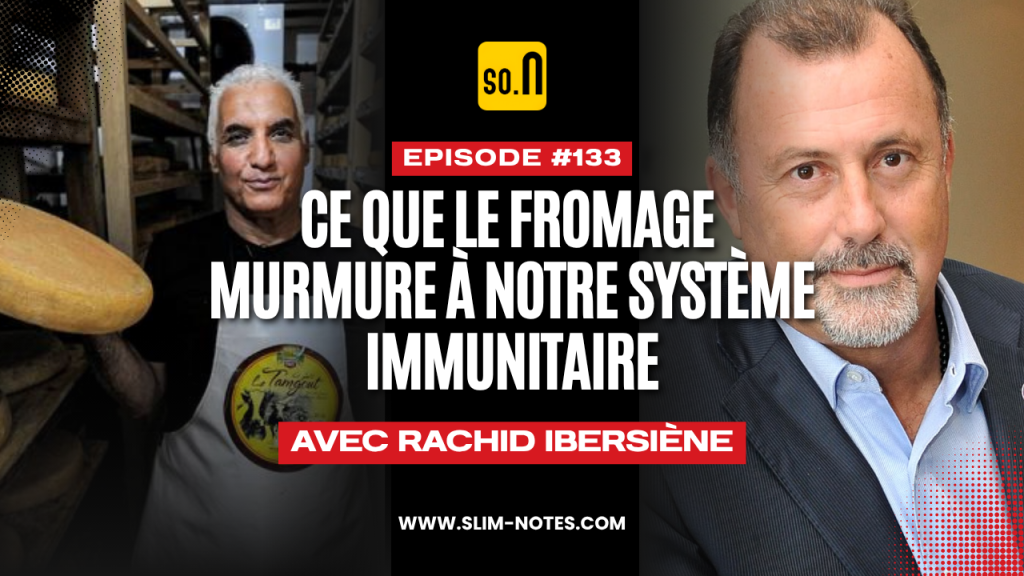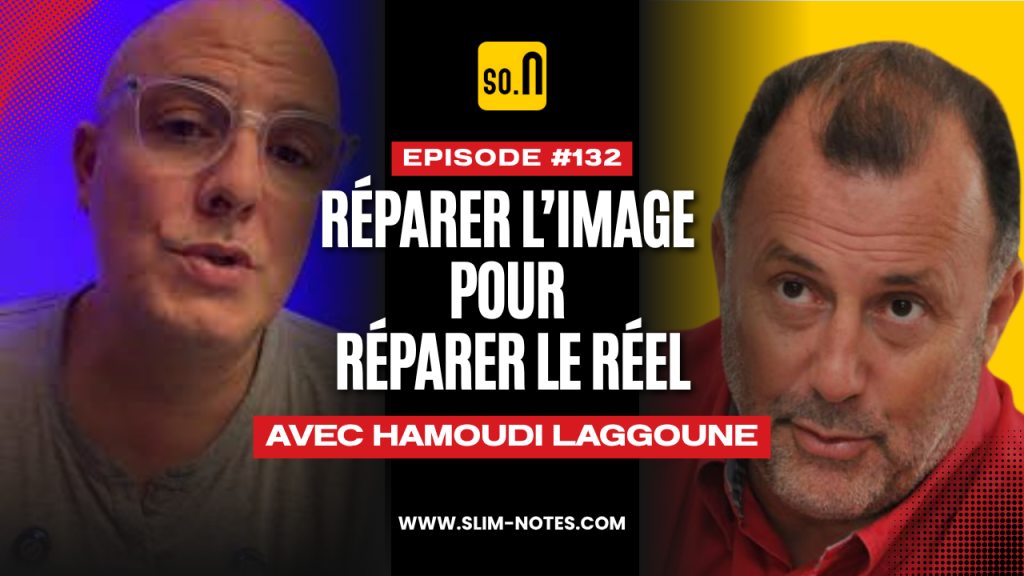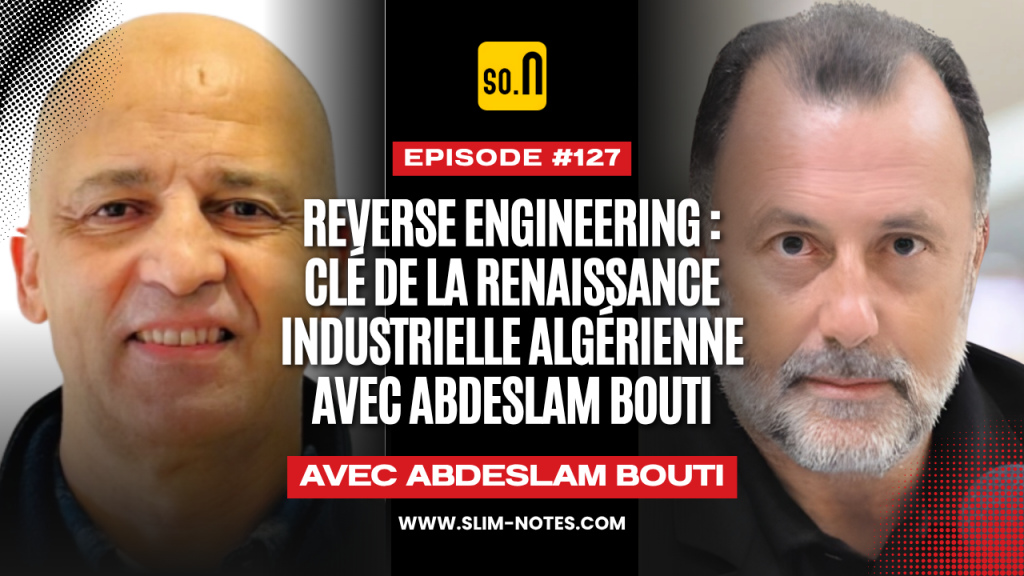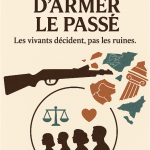“les vivants décident pas les ruine
الأحياءُ يقرّرون، لا الأطلال The living decide, not the ruins”
(en version FR, AR, Eng)

On convoque l’histoire et l’archéologie pour tout justifier : frontières “naturelles”, annexions “légitimes”, hiérarchies “ancestrales”. Une ruine devient slogan, une datation se change en verdict, une carte jaunie sert de mandat moral. Je ne crois pas que le passé doive trancher nos désaccords présents. L’histoire et l’archéologie sont des méthodes. Elles produisent des connaissances révisables, avec des zones d’incertitude. En faire des juges, c’est confondre savoir et pouvoir.
Sur les réseaux, je vois défiler des copies de cartes, des photos de fouilles, des citations anciennes brandies comme preuves “ultimes”. Image contre image, légende contre légende. J’ai déjà cliqué trop vite, moi aussi. Désormais, je ralentis : qui parle, quand, pour quoi ? Qu’est-ce que la carte montre et qu’est-ce qu’elle efface ? Le texte cité, d’où vient-il vraiment ? Existe-t-il une lecture qui contredit ou nuance ? Et surtout : même solide, une trace du passé n’édicte pas la norme d’aujourd’hui. Si je partage, je donne le contexte et j’assume l’incertitude. Ce n’est pas de la manie ; c’est une façon d’éviter de nourrir, malgré moi, ce qui sert à justifier l’injustifiable. Je vois aussi des forces très concrètes pousser à cet usage tordu du passé. Pas besoin de grands mots :
• Technocratie des chiffres : on veut que tout colle au modèle, puis on exige du passé qu’il valide le modèle.
• Court-termisme financier : l’histoire se réduit à un pitch efficace.
• Propagande de plateforme : l’émotion prend toute la place, le contexte disparaît.
• Tribalismes identitaires : on ethnicise le patrimoine, on fabrique des ennemis.
• Réflexe sacrificiel : on cherche des coupables à offrir à la stabilité du groupe.
Face à ça, je ne demande pas “plus de preuves”. Je demande un meilleur usage des preuves. Et un rappel simple : ce sont les vivants qui décident, ici et maintenant.
Trois mises au point, sans posture :
1) La preuve définitive n’existe pas. Un tesson, une inscription, une carte d’empire décrivent un état du passé. Ils ne donnent pas un droit éternel sur des gens d’aujourd’hui.
2) La continuité pure est un mythe. Les sociétés changent, se mélangent, se recomposent. Les identités sont faites d’alliages et de ruptures.
3) La neutralité n’est jamais donnée. Choisir un site, un corpus, un siècle, c’est déjà interpréter. Les agendas, les financements, les imaginaires pèsent. Autant l’admettre.
Que peuvent l’histoire et l’archéologie ? Dire comment on sait (méthodes, bornes, marges d’erreur). Dire où l’on ne sait pas (zones grises, hypothèses rivales). Et reconnaître ce qu’elles ne tranchent pas : la norme politique du présent. L’égalité, la dignité, la sécurité, la justice ne sortent pas d’un parchemin ni d’un mur antique. Elles relèvent d’un choix juridique et moral aujourd’hui.
Je n’oppose pas le sang-froid à l’indignation. L’indignation reste légitime. Je refuse seulement de transformer une trace en talisman, une carte en sentence, une fouille en excommunication. Le passé éclaire ; il ne gouverne pas. Les responsables qui brandissent des reliques pour retirer des droits se trompent d’outil. Les médias qui mettent en scène des “découvertes” à portée politique sans contrechamp brouillent le sens. Et nous tous, quand on relance la bataille d’images sans contexte, on aide — parfois sans le vouloir — à habiller l’injustifiable.
Je ne propose ni dogme ni retour à un âge d’or. Je propose un refus clair : ne pas asseoir des décisions présentes sur des objets arrachés à leur contexte ; ne pas faire du passé un tribunal ; ne pas confondre vérité de méthode et décision politique. Ma boussole tient en deux mots : dignité des vivants et honnêteté du savoir. La première ne se négocie pas. La seconde demande du temps, du doute et du débat — y compris quand cela froisse nos appartenances.
Le problème n’est pas le passé, c’est son usurpation. Je continuerai de prendre trente secondes avant de partager ce qui “prouve tout”, de dire ce que je sais et ce que j’ignore, et de tenir cette ligne : aucune ruine, aucune carte, aucun texte ne peut justifier qu’on retire à des êtres humains leurs droits égaux. Le reste — trophées archéologiques, cartes brandies — c’est du bruit. Ce qui compte, ce sont nos choix présents, face à des vies présentes.
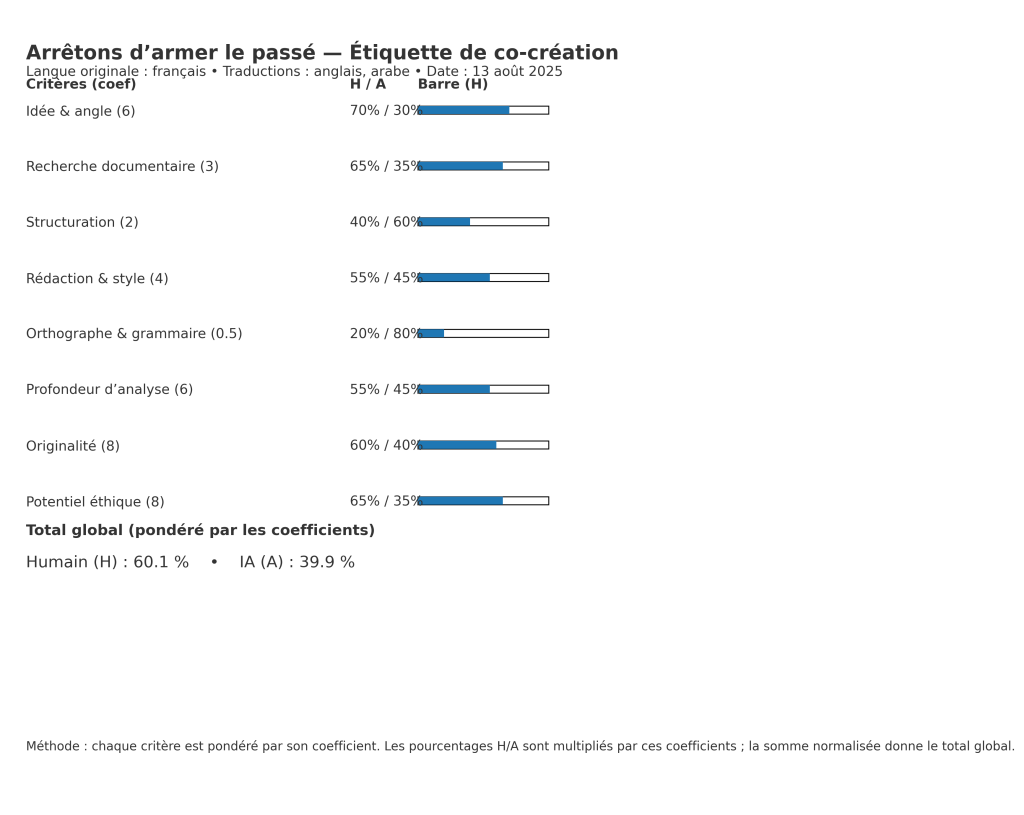
لنوقف تسليح الماضي
الأحياءُ يقرّرون، لا الأطلال
يُستَحضَر التاريخ وعلم الآثار لتبرير كل شيء: حدود «طبيعية»، ضمّ «شرعي»، تراتبيات «سلفية». يتحوّل الأثر إلى شعار، والتأريخ إلى حكم، والخريطة الصفراء إلى تفويضٍ أخلاقي. لا أرى أن على الماضي أن يحسم خلافات الحاضر. فالتاريخ والآثار مناهج، تنتج معرفةً قابلةً للمراجعة، وبها مناطق من عدم اليقين. تحويلهما إلى قضاة خلطٌ بين المعرفة والسلطة.
على الشبكات، أرى نسخًا من خرائط قديمة وصور حفريات واقتباسات عتيقة تُلوَّح كأنها «أدلة قاطعة». صورةٌ تقابل صورة، وتعليقٌ يردّ على تعليق. أنا أيضًا ضغطتُ «نشر» على عجل من قبل. اليوم أُبطئ: من المتحدث؟ متى؟ ولأي غرض؟ ماذا تُظهِر الخريطة وماذا تُخفي؟ ما أصل النص المقتبس حقًّا؟ هل توجد قراءة تُناقِض أو تُصحّح؟ والأهم: حتى لو كانت الدلالة قوية، فلا أثرٌ من الماضي يفرض معيار اليوم. إن شاركتُ، أضيف السياق وأعترف بحدود اليقين. هذا ليس تكلّفًا؛ بل طريقة لتجنّب تغذية ما يُستخدَم لتبرير ما لا يُبرَّر.
أرى أيضًا قوىً ملموسة تدفع نحو هذا الاستخدام الأعوج للماضي. بلا تهويل:
• تكنوقراطية الأرقام: نريد لكل شيء أن يطابق النموذج، ثم نُرغِم الماضي على ختم النموذج.
قصيرُ النظر المالي : يُختزَل التاريخ في عرضٍ تسويقي سريع .
دعايةُ المنصّات : العاطفة تملأ المشهد والسياق يتبخّر .
قبَلياتٌ هوياتية : تُقوْلب الذخيرة الثقافية ويُصنَع الأعداء .
• غريزةُ التضحية: البحث عن مذنبين يُقدَّمون قرابين لاستقرار الجماعة.
أمام ذلك لا أطالب بـ«مزيد من الأدلة»، بل بـ حُسن استخدام الأدلة. وتذكير بسيط: القرار يصنعه الأحياء، هنا والآن.
ثلاثُ توضيحاتٍ مباشرة:
لا وجود لـ«دليل نهائي». الشَّقف، النقش، خريطةُ إمبراطوريةٍ تصف حالًا من الماضي؛ لا تمنح حقًّا أبديًّا على أناس الحاضر .
«الاستمرارية الخالصة» أسطورة. تتغيّر المجتمعات وتختلط وتُعاد صياغتها؛ والهويات سبائكُ وقطائع .
الحياد ليس معطًى. اختيارُ موقعٍ أو متنٍ أو قرنٍ هو تفسيرٌ مسبق. للأجندات والتمويلات والخيال الجمعي أثرٌ لا يُنكَر .
ماذا يمكن للتاريخ والآثار أن يقدّما؟ أن يبيّنا كيف نعرف (مناهج، حدود، هوامش خطأ)، وأين لا نعرف (مناطق رمادية، فرضياتٌ منافِسة)، وأن يُقِرّا بما لا يبتّان فيه: معايير السياسة اليوم. المساواة والكرامة والأمن والعدالة لا تخرج من رقٍّ قديمٍ ولا من جدارٍ أثري؛ بل من اختيارٍ قانوني وأخلاقي الآن.
لا أضع رباطة الجأش في مواجهة الغضب الأخلاقي؛ الغضب مشروع. أرفض فقط أن يتحوّل الأثر إلى تميمة، والخريطة إلى حكمٍ باتّ، والحفريّة إلى حرمانٍ من الشرعية. الماضي يُنير؛ لكنه لا يحكم. من يلوّحون بذخائر لإسقاط حقوق الناس يسيئون اختيار الأداة. ومن يصنعون «اكتشافات» سياسية بلا منظورٍ مُضاد يربكون المعنى. ونحن جميعًا، حين نُغذّي معركة الصور بلا سياق، نُسهم — أحيانًا من دون قصد — في تزيين ما لا يُبرَّر.
لا أدعو إلى عقيدةٍ جديدة ولا إلى حنينٍ لزمنٍ ذهبي. أدعو إلى رفضٍ واضح: ألّا تُبنى قرارات الحاضر على أشياء منزوعةٍ من سياقها؛ ألّا يتحوّل الماضي إلى محكمة؛ ألّا تختلط حقيقةُ المنهج بقرار السياسة. بوصَلتي كلمتان: كرامة الأحياء وأمانة المعرفة. الأولى غير قابلة للمساومة، والثانية تحتاج وقتًا وشكًّا ونقاشًا — حتى لو أغضب انتماءاتنا.
المشكلة ليست الماضي، بل اغتصابه. سأواصل أن أتريّث ثلاثين ثانية قبل مشاركة ما «يُثبت كل شيء»، وأن أُصرّح بما أعلم وما أجهل، وأن أتمسّك بهذه القاعدة: لا أثر، ولا خريطة، ولا نصّ يبرّر سلب حقوقٍ متساوية عن بشرٍ أحياء. أمّا الباقي — غنائم أثرية وخرائطُ مرفوعة — فمجرد ضجيج. ما يهمّ هو خياراتنا الآن أمام حيواتٍ الآن.
Stop Arming the Past
The living decide, not the ruins.
History and archaeology get invoked to justify everything: “natural” borders, “legitimate” annexations, “ancestral” hierarchies. A ruin turns into a slogan, a dating into a verdict, a yellowed map into a moral warrant. I don’t believe the past should settle our present disagreements. History and archaeology are methods. They produce revisable knowledge, with zones of uncertainty. Turning them into judges confuses knowledge with power.
On social networks I see copies of old maps, excavation photos and ancient quotes waved as “ultimate” proof. Image against image, caption against caption. I’ve clicked too fast before, too. Now I slow down: who is speaking, when, and for what purpose? What does the map show—and what does it erase? Where does the quoted text really come from? Is there a reading that contradicts or qualifies it? And above all: even a solid trace from the past does not dictate today’s norms. If I share, I add context and I acknowledge uncertainty. That’s not fussiness; it’s a way to avoid feeding, despite myself, what gets used to justify the unjustifiable.
I also see very concrete forces pushing toward this twisted use of the past. No need for grand words:
• Technocracy of numbers: we want everything to fit the model, then we demand the past to validate the model.
• Financial short-termism: history gets reduced to an efficient pitch.
• Platform propaganda: emotion takes all the space, context disappears.
• Identity tribalisms: heritage is ethnicized, enemies are manufactured.
• Sacrificial reflex: we look for culprits to offer to the stability of the group.
In front of this, I don’t call for “more evidence”. I call for better use of evidence. And for a simple reminder: the living decide, here and now.
Three quick clarifications:
1) There is no definitive proof. A sherd, an inscription, an imperial map describe a state of the past. They don’t grant eternal rights over people today.
2) Pure continuity is a myth. Societies change, mix and recombine. Identities are made of alloys and ruptures.
3) Neutrality is never given. Choosing a site, a corpus, a century is already interpretation. Agendas, funding, imaginaries weigh in. Better to admit it.
What can history and archaeology do? Say how we know (methods, bounds, margins of error). Say where we don’t know (gray areas, rival hypotheses). And recognize what they don’t settle: today’s political norms. Equality, dignity, security, justice don’t spring from a parchment or an ancient wall. They stem from a legal and moral choice today.
I’m not opposing composure to indignation. Indignation is legitimate. I refuse only to turn a trace into a talisman, a map into a sentence, an excavation into an excommunication. The past informs; it doesn’t govern. Officials who wave relics to strip people of rights are using the wrong tool. Media that stage “discoveries” with political reach and no counter-shot muddy the waters. And all of us, when we fuel the image battle without context, help—sometimes unknowingly—to dress up the unjustifiable.
I’m proposing neither a dogma nor a return to a golden age. I’m proposing a clear refusal: don’t rest present decisions on objects torn from their context; don’t turn the past into a court; don’t confuse methodological truth with political decision. My compass fits in two words: the dignity of the living and the honesty of knowledge. The first is non-negotiable. The second requires time, doubt and debate—even when it ruffles our allegiances.
The problem isn’t the past, it’s its usurpation. I’ll keep taking thirty seconds before sharing what “proves everything”, stating what I know and what I don’t, and holding this line: no ruin, no map, no text can justify stripping human beings of equal rights. The rest—archaeological trophies, brandished maps—is noise. What matters are our present choices, in front of present lives.



